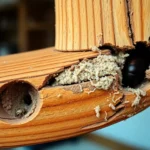Starting a Poulan chainsaw might seem like a daunting task, especially if you’re new to the world of power tools. But don’t worry, we’ve got you covered. Whether you’re gearing up for a big project or just need to do some quick yard work, knowing how to properly start your chainsaw is the first step to getting the job done right.
We understand the importance of safety and efficiency when it comes to operating any power tool. That’s why we’re here to guide you through the process, step by step. With our help, you’ll have your Poulan chainsaw up and running in no time, ready to tackle whatever task lies ahead. So let’s get started and turn that daunting task into a walk in the park.
Preparing to Start Your Poulan Chainsaw
Embarking on any task requires proper preparation, and starting your Poulan chainsaw is no exception. Let’s ensure everything is set correctly for a smooth, safe start.
Gather Necessary Materials
To efficiently start your Poulan chainsaw, compile the essential items:
- Protective Gear: Safety glasses, gloves, and hearing protection.
- Fuel: A mix of gasoline and two-cycle chainsaw oil, according to your model’s specifications.
- Chainsaw Bar Oil: For lubricating the chain and bar.
- Screwdriver: For any adjustments needed on the chainsaw.
- Cleaning Cloth: To wipe down the chainsaw, ensuring it’s clean before use.
Having these materials at hand not only facilitates a smoother starting process but also promotes a safer working environment.
Ensure Safety Measures Are in Place
Safety cannot be overstated when preparing to start your Poulan chainsaw. Adopt these practices to minimize risks:
- Check the Chainsaw’s Condition: Inspect the chainsaw for loose screws, damaged parts, or signs of wear that could pose risks during operation.
- Position the Chainsaw Properly: Place it on flat, stable ground, ensuring there’s no obstacle around that might interfere with the starting process or pose a tripping hazard.
- Engage the Chain Brake: This prevents the chain from moving during start-up, reducing the risk of injury.
- Clear the Area: Ensure you have ample space around you, free from debris and other materials that could obstruct your movement or catch onto the chainsaw.
- Inform Others: If you’re not alone, let those around you know you are about to start the chainsaw, encouraging them to keep a safe distance.
Adhering to these safety measures ensures not only your well-being but also that of those around you, setting a solid foundation for a successful and efficient chainsaw operation.
Inspecting Your Chainsaw
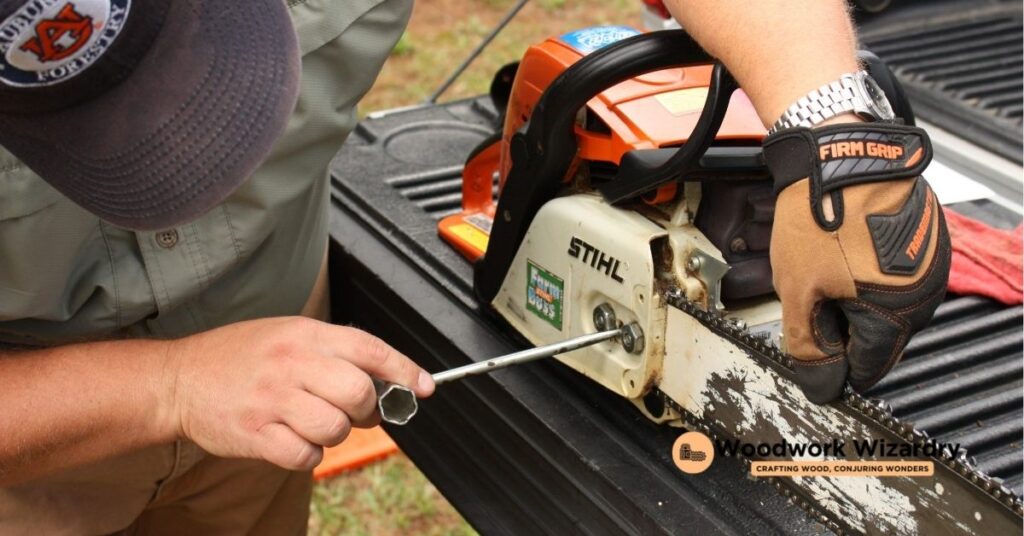
Before attempting to start your Poulan chainsaw, a thorough inspection is paramount. This ensures both safety and efficiency throughout its operation.
Checking the Chain Tension
Ensuring the chain tension is correct prevents slippage or snapping, which can be dangerous during use. Adjust the chain so that it fits snugly against the guide bar but still allows for smooth rotation by hand. If the chain droops from the bar or is too tight to move, adjust it using a screwdriver until you achieve the right tension.
Inspecting the Fuel and Oil Levels
Adequate fuel and oil levels are crucial for the chainsaw’s performance and longevity. Check that the fuel tank is filled with the correct mixture of gasoline and oil, specific to your Poulan chainsaw model. The oil reservoir should also be full to ensure proper chain lubrication. Refill both tanks if levels are low to prevent damage and ensure optimal operation.
Ensuring the Saw Is Clean and Unobstructed
A clean chainsaw ensures better air flow and cooling during operation. Wipe down the saw’s body, removing any debris, dust, or wood chips that could obstruct the air filter or exhaust. Inspect the air filter and clean or replace it if it’s dirty. Ensure the chain’s path is free from obstructions, allowing for smooth and safe cutting action.
Starting the Chainsaw
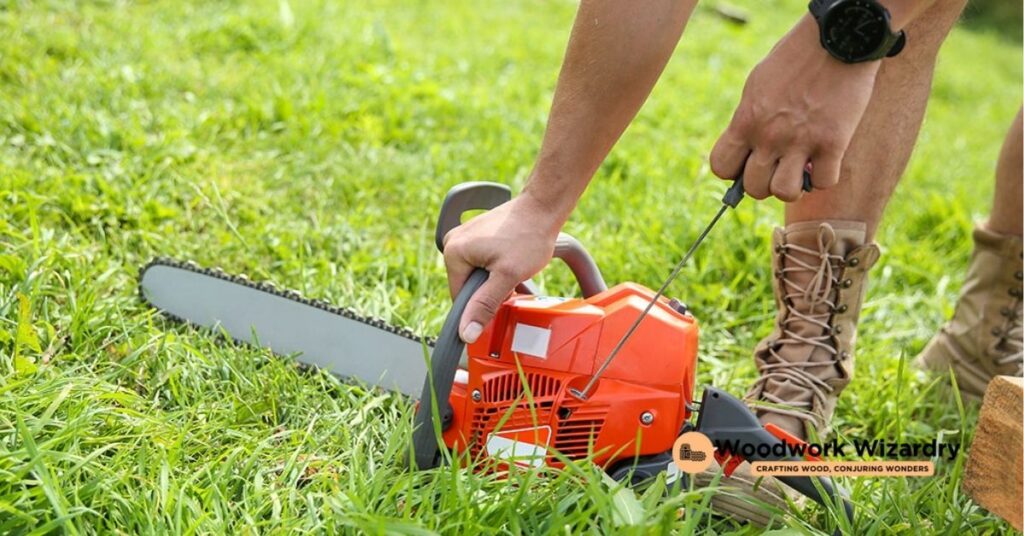
Having prepared the Poulan chainsaw and ensured all safety measures are in place, it’s time to start the chainsaw. This step-by-step guide will walk you through the process, ensuring your chainsaw starts smoothly and safely.
Engaging the Chain Brake
Engage the chain brake by pushing it forward before starting. Doing this ensures safety, preventing the chain from accidentally moving during startup. The chain brake acts as a critical safety measure, and engaging it is a must for both inexperienced and seasoned users.
Setting the Choke to the Starting Position
Move the choke to the starting position if your chainsaw is cold. This adjustment enriches the fuel mixture, aiding in the startup process of a cold engine. Chainsaws require a richer fuel mix to start when they haven’t been running, and adjusting the choke properly facilitates this.
Priming the Fuel System
Press the primer bulb three to five times to prime the fuel system. Priming introduces the necessary amount of fuel to the carburetor, making the engine ready for a successful start. This step is crucial, especially if the chainsaw has been sitting unused for some time or is being started for the first time of the day.
Pulling the Starter Rope
Hold the chainsaw firmly on the ground, placing one foot on the rear handle for stability. Pull the starter rope sharply with your dominant hand until the engine fires. It may require several pulls to get the engine running. Once the engine runs, push the choke back in to avoid flooding the engine. If the chainsaw doesn’t start after several attempts, allow it a few moments to rest before trying again, ensuring not to flood the engine with excess fuel.
By following these steps diligently, your Poulan chainsaw will start smoothly, allowing you to proceed with your cutting tasks safely and efficiently.
After the Start
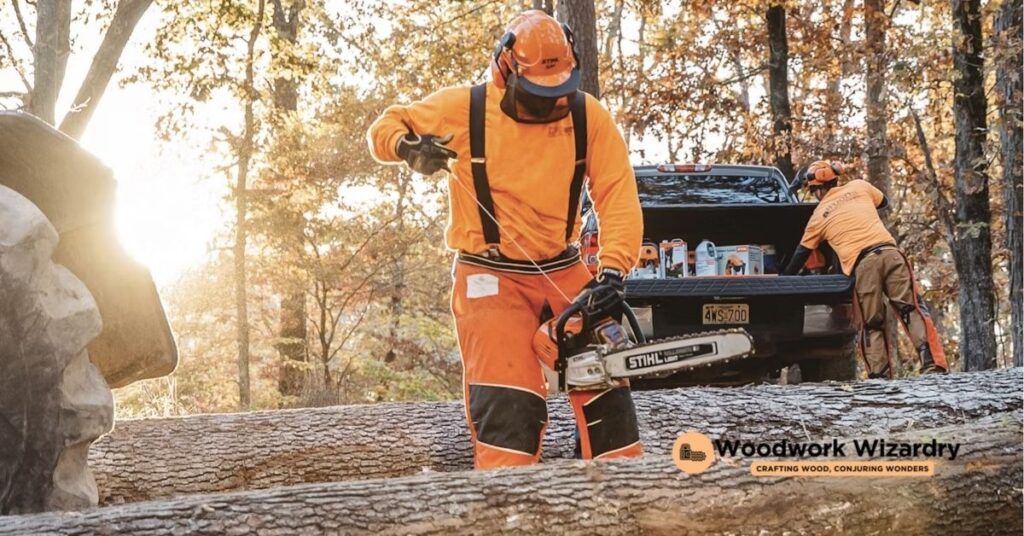
Successfully starting your Poulan chainsaw marks just the beginning of your cutting task. Ensuring the chainsaw operates effectively and safely requires a few steps once it roars to life.
Disengaging the Choke
Immediately after your Poulan chainsaw starts and runs, it’s time to disengage the choke. Doing this allows the chainsaw to operate smoothly under normal conditions. If the chainsaw begins with the choke in the full position, move it to the half-choke position once the engine fires up. Once the engine runs and warms up for a few seconds, fully disengage the choke by moving it to the “off” position. This action ensures that the chainsaw transitions from starting mode to operational mode without stalling or running too rich, which could cause it to flood.
Releasing the Chain Brake
With the engine running and the choke successfully disengaged, the next step involves releasing the chain brake. The chain brake is a critical safety feature that prevents the chain from moving when not actively cutting. To release the chain brake, pull the chain brake handle towards you until you hear a click, signaling the brake is disengaged. This allows the chain to move freely, and your Poulan chainsaw is ready for use. Remember, always engage the chain brake again when you stop cutting or need to move to another location. This ensures safety and prevents accidental starts of the chain.
Tips for Smooth Operation
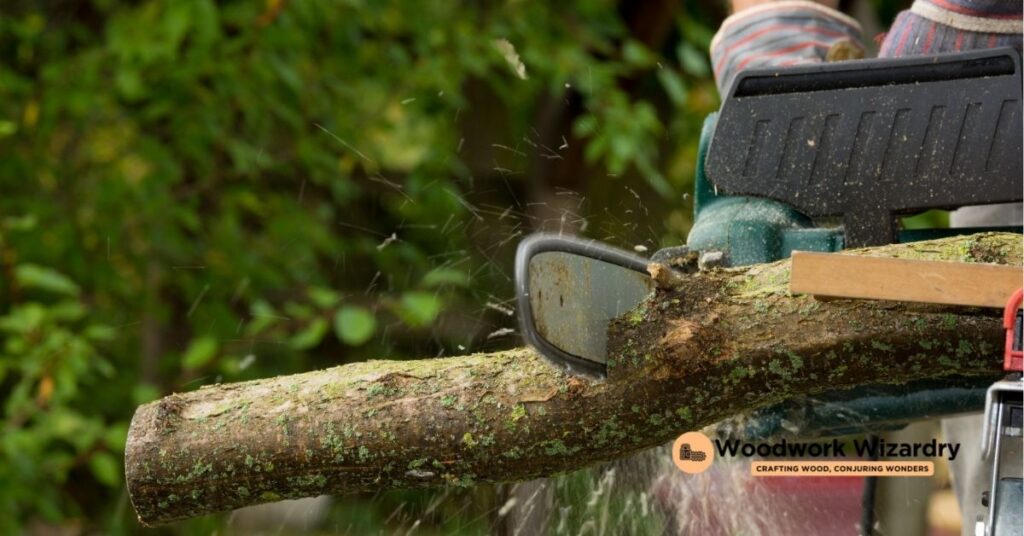
Ensuring your Poulan chainsaw operates smoothly involves regular upkeep and the use of proper materials. Let’s dive into some key practices that will help maintain your chainsaw’s efficiency and longevity.
Using Fresh Fuel
Keeping fuel fresh plays a critical role in the smooth operation of your Poulan chainsaw. Stale fuel can lead to hard starts, poor performance, and even damage to the engine. Always use fresh gasoline with a minimum octane rating of 89 and mix it with two-cycle oil at a ratio of 40:1, unless specified otherwise by your chainsaw model. If your chainsaw sits idle for more than a month, drain the old fuel from the tank and replace it with a fresh mix. This ensures the engine starts easily and runs smoothly.
Regular Maintenance Checks
Conducting regular maintenance checks guarantees your chainsaw remains in optimal condition. Routine inspections and adjustments are necessary to prevent problems before they escalate. Key areas to focus on include:
- Chain Sharpness: Check the sharpness of your chainsaw chain regularly. A dull chain makes cutting inefficient and increases the risk of kickback.
- Chain Tension: Ensure the chain fits snugly against the guide bar but still rotates freely without sagging. Adjust the tension as needed before each use.
- Air Filter: Clean or replace the air filter frequently to ensure the engine receives enough air for combustion. A clogged air filter forces the chainsaw to work harder, decreasing its efficiency.
- Spark Plug: Inspect the spark plug periodically. Replace it if it’s fouled or worn out to ensure reliable starting and optimum performance.
- Fuel System: Keep the fuel system clean by using fresh fuel mix and checking for any leaks or damage to fuel lines.
Incorporating these habits into your chainsaw maintenance routine enhances performance, extends the life of your chainsaw, and maintains a safer working environment.
Troubleshooting Common Issues
Even with thorough preparation and maintenance, Poulan chainsaws might encounter operational issues. Below, we delve into common problems and their solutions, ensuring a smooth chainsaw experience.
Chainsaw Won’t Start
Ensuring the ignition switch is in the “on” position is the first step when a chainsaw fails to start. Next, verify that there’s enough fresh fuel in the tank if the chainsaw remains unresponsive. Checking the spark plug for fouling is crucial; a clean, properly gapped spark plug ignites the fuel effectively. Cleaning the air filter also improves airflow, essential for starting. If the chainsaw still won’t start after these checks, inspect the fuel filter and lines for blockages that might prevent fuel from reaching the engine.
Chainsaw Starts then Stalls
A chainsaw that starts but soon stalls typically suffers from a fuel mixture issue. Running on a fuel mix that’s more than one month old can cause this problem. Draining old fuel and refilling with a fresh mixture often resolves the issue. Additionally, a clogged carburetor or a dirty fuel filter restricts fuel flow, leading to stalling. Cleaning the carburetor and replacing the fuel filter can restore normal operation. Furthermore, ensure the air filter is clean to allow for proper air intake.
Difficulty Pulling the Starter Rope
When encountering resistance while pulling the starter rope, first ensure the chainsaw’s brake is disengaged. If the brake is engaged, it locks the chain, making it difficult to pull the rope. Another potential issue is a flooded engine, indicative of excessive fuel in the engine cylinder. In this case, position the choke in the “run” setting and pull the starter rope several times to clear the excess fuel. Additionally, check for debris around the starter mechanism and chainsaw sprocket, as build-up can hinder the rope’s movement. If the issue persists, inspect for damage to the pull cord assembly or recoil spring, which may require replacement.
Conclusion
We’ve walked through the essentials of getting your Poulan chainsaw up and running smoothly. Remember the importance of preparation and safety first. With the right care and attention to maintenance including fresh fuel and regular checks on key components your chainsaw should serve you well through many tasks. If you encounter any hiccups along the way our troubleshooting tips are here to help. Here’s to many successful starts and safe operations with your Poulan chainsaw!
Related Posts:
- Can You Put a Longer Bar on Your Chainsaw? Compatibility & Installation Guide
- Step-by-Step Guide: How to Adjust Chainsaw Carburetor for Optimal Performance
- Ultimate Guide: How to Clean Your Chainsaw Carburetor for Peak Performance
- Safe Hedge Trimming: How to Cut Hedge with Chainsaw & Avoid Mistakes
- Ultimate Guide: How to Measure Chainsaw Bar Chain for Optimal Use
- How to Start a Poulan Chainsaw: A Step-by-Step Guide
- Understanding Chain Pitch: Essential for Smooth Machinery Operation
- Beginner’s Guide to Chip Carving: Tools, Techniques, and Tips








